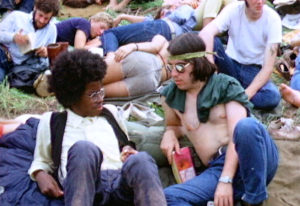Ok, so this is a long one. Maybe only for those who are REALLY interested in what is going on with my GFRF… You may have noticed that I like to explain things in detail. Hopefully this is helpful a lot of the time, and perhaps even endearing some of the time. But it does also mean you sometimes need to read through a lot of material to get that detail.
TL;DR
So here is the TL;DR: I need to balance the energy I put in to my qigong teaching, and the energy I receive back in return. To try to accomplish this I am going to password restrict access to some of my online training materials. This will create a barrier of sorts to protect the ‘flame’ of my personal energy from the winds of a harsh economic environment. I will have greater control over the use of my time and energy and who has access to it to reduce the drain on me. It will also create a much stronger decision point for people to decide to donate or not and how much. I will keep it GFRF for now and see how it goes.
If you do want to read the rest of the post though, I would recommend it. I have even included some pictures and videos to keep it interesting for you!
Difficulties
I am finding these recent posts difficult to write, but when I first started out on my ‘Give Freely, Receive Freely’ experiment I committed to documenting my experiences and the results, good or bad, or otherwise it would not be a very honest representation of the experiment.
If anything I have held back on writing about just how difficult it has been for me to continue to do things by ‘Give Freely, Receive Freely’, because who wants to be complaining all the time? I would much rather focus on the positive, and also I committed to gladly accept whatever I received without complaint – otherwise I would not truly be giving freely or receiving freely. But now that it has become necessary for me to make changes to how I am doing things, I think I also need to write a little more about the challenges I have had while using GFRF.
Protecting the flame
An analogy that occurred to me that would describe some aspects of the challenges pretty accurately is that of a flame. I often refer to a flame when teaching about breathing and qigong. How for a flame to be healthy and strong it needs enough air, but also not too much. Think of a candle, without enough air the flame will be smothered. With too much air, in a breeze or wind, the flame will splutter, and maybe even be blown out.
Having tried using GFRF for over five years now, I have often considered other types of arrangement that have similarities to see what makes them work or not work, and using the analogy of a flame, from what I have seen there is a feature that seems to be almost universal in examples of successful use off GFRF principles or similar. There is always, or almost always some kind of barrier or buffer of protection for the people using GFRF that allows them to do it successfully. Something that protects their flame from the winds of this
I will mention several examples and explain:
The Monastery
Being in Thailand recently and seeing the monks going around and collecting food from devotees each morning brought this one strongly to mind again. The monks do not work for money, relying on donations for their support so would seem to be using GFRF pretty well. BUT, they are also supported by the infrastructure in place at the monastery, they don’t have to worry about things like paying rent, and the monastery often has financial reserves from previous bequests and donations.

They also benefit from a cultural understanding and tradition of supporting them in this way. All of these things contribute to them being able to function in this way, and in the end they don’t fully engage with the world, they retreat from it. They don’t need to pay taxes, they don’t need to provide for a family etc etc.
The Commune
This is another example of a group of people together trying their best to live by GFRF principles or similar. A larger flame is harder to blow out than a small one, so by working together and sharing freely with each other they are able to benefit from their collective strength and provide for their needs together in ways that they could not individually. These communes usually start out with property purchased from the collective finances of the founding members, so again they don’t need to worry about that very basic need of at least having somewhere to live, their daily efforts are usually more about taking care of their daily needs and possibly developing their property further. But they do this within the sheltered environment of their communal society.

They share freely with each other, but are usually isolated to a large extent from the rest of the world. If they have to interact with the rest of the world, they usually do so on normal commercial terms, buying and selling. They attempt to create a protected oasis from the outside world in their commune where they can live the way they truly want to. BUT, this isolation and strong reliance on each other also creates challenges. If you are familiar with the history of various communes you will know that scandals are common, and often members end up being taken advantage of in different ways by the unscrupulous and power hungry among them. Because of their reliance on the group and lack of personal property it makes it difficult for them to leave, and unfortunately there are very very few examples of communes that have managed to be successful and healthy environments for their members to live in for the long run, and so so many examples of communes that have broken up and fallen apart because of abuse within them. I have actually wanted to write an in depth blog post about communes and the challenges involved in them and possible other ways of looking at achieving the same purposes for quite awhile, but just haven’t had the time as I have been working so hard on other things. Perhaps I will get to do that in the future.
The Foundation or Charity
I don’t actually think these are a very good example of GFRF because they are not usually about exchange and mutual support. They do however represent people’s desire to give to help other’s and to create a better world. BUT, usually the money that flows through these organizations has been obtained by usual commercial means – work, business, investment, and so on.

And those working in the charities are a combination of volunteers who do the work for no compensation – they do not rely on it to support themselves, and employees – who are working on a normal commercial basis as they would with any other job. Some employees in charities are even paid hundreds of thousands or even millions of dollars annually, and for them their working situation is really not too different from working in any other industry sector. I will comment more on how this relates to GFRF a little later in this post.
The Academic Institution
This is an interesting one. Sometimes academics once they have been granted tenure then find themselves free to put their efforts into researching and teaching whatever they think is most valuable.

They are able to freely give their intellectual efforts to the world, but they are clearly very protected from the economic realities due to the backing of the institution they are part of which may be funded by the government – indirectly through taxes, or by private donors. They may indeed be giving freely, but they do so from an extraordinarily protected financial position, which leads to the sometimes criticisms of academics in their ivory towers being out of touch with the realities of the world.
The Independently Wealthy – or Significant Asset Base
Another group who sometimes seem to manage to do something like GFRF is those who are already wealthy, or at least have a significant asset base to start with. These people are sometimes able to give their services freely and support themselves by doing this, but they are not truly meeting the full cost of their living because they are doing so supported by the asset base they have already accumulated through more normal means whether it be work, investment, inheritance or so on. This then gives them the security and freedom to operate in this way.

The people who do this are few and far between, and I think those that do are wonderful and embracing the spirit of what I have referred to as GFRF (sometimes other people use other terms to describe their philosophy), but in a practical analysis it can’t be ignored that their base of assets is a big part of what allows them to do this successfully. One of the best examples of GFRF that I know of is not wealthy as such, but does benefit from owning a substantial piece of property that allows them to do what they do in the way that they do it, and they are an inspiration.
The Supported Partner
Another type of person that may be using GFRF is the person who works at something that is their passion and chooses to do it in a GFRF way because they want to share what they have with others, and it feels good and right and freeing to do it GFRF (I feel this way too J). They are able to get some return in this way so it seems like it is working for them, but if you dig deeper into their financial situation they are not actually supporting themselves fully in this way.

They have a partner, or someone else who has a significant income from a more normal job or a significant asset base etc which is paying for a significant part of their living costs. The GFRF work is either just a hobby, or a part-time supplemental income, not an income that would actually meet their financial needs fully. To do that they need the support of another. This support protects and shields them to some extent from the harsh economic realities of their environment.
The Side Project
Another example of someone using GFRF for their work is someone who uses it just for a portion of their work. This allows them to use GFRF because they want to, but the bulk of their income and financial support comes from a more regular job or business. Again shielding their side project from the economic winds around them.
How do these examples compare to my GFRF
I applaud any and everyone’s efforts to use the principles of GFRF, or to otherwise act charitably. I think any effort in this direction is wonderful and my intent is certainly not to be critical of peoples efforts in any way, but simply to examine closely and rationally how things are working to learn from them, and some kind of ‘shielding’ or protection seems common in I think pretty much every example of successful GFRF like situations that I have come to be aware of. There may be exceptions of course, and that is great. But this seems to be the general pattern.
So how do these examples compare to what I have been doing with GFRF?
First the monastery. I am not working as part of a religious order. My intention is not to retreat from the world but to engage fully with it. I think when we retreat from the world we reduce our influence on it. We are most influential when we are in it and part of it, as such I have the same economic needs as other people in society, which are quite different from the monk in retreat. Because I am not part of an established tradition I so often encounter confusion and misunderstanding of how to interact with GFRF, and if I want to have any success with it have to put a lot of effort simply into communicating this rather than getting on with giving the other things I have to give. Also because of the perceived similarity to how monks live, I from time to time encounter people assuming that I am just like a monk of some sort… I may be choosing to use some of the same underlying principles of how I want to interact with people compassionately, but I am definitely not a monk. I am also not supported in my travels and efforts by a large established organization with financial resources, which is sometimes assumed as well. I am doing everything off my own back, and out of my own pocket. When my pocket empties out, there is not another reserve for me to draw on.
Next the commune. Well… I am not secluding myself from the world. I am not only giving to those within my select community who have agreed to common principles and also give freely back to me in the same way. I have no such community to support and strengthen me. I guess in a small way I have wanted to encourage development of a community like this of sorts by having the GFRF website and sharing my experiences on it. Also listing the details of other people who are using GFRF or similar as I have come across them. But we are few and dispersed and unable to meet each other’s needs in this way. I have also specifically wanted to keep my giving and my interaction open to the world at large to influence, share, and spread the ideals of GFRF by letting people come into contact with it, and also to avoid some of the potential pitfalls of a closed commune type environment. I guess my hope – and I realised that it was an idealistic and perhaps unrealistic hope this could spark wider change. In the least people would become more comfortable interacting with GFRF, and perhaps it might inspire a more giving and compassionate environment for all of us as more people tried GFRF or similar in their lives. But overall my efforts have been very much exposed to the regular everyday economic environment, and that was always my intention.
The Foundation or Charity. I think you can definitely consider what I have been doing as charity in the sense that it is giving inspired by love and compassion. But it is not charity in the sense of the word in the way that most people commonly use it, in that I do not benefit from some people giving to me financially so that I can then give my services to others. My idea has always been that if at all possible there needs to be reciprocity. Those receiving need to give in return. Charity in the sense it is commonly used implies giving in one direction. This implies that there are those that can give, and those that can receive. This creates a kind of inequality and often on a deep level is not beneficial to the receivers as it creates a mindset of dependency and that they are unable to give that is hard for them to break out of. When there is reciprocity it recognises the fundamental worth and equality of us all, and our mutual dependence on each other. We all become both givers AND receivers. Some may be able to give more, and others less, but that all balances out in the end and everyone’s contribution is valuable and necessary to our overall wellbeing and success.
I have thought about the possibility of seeking charitable status which would make my activities tax exempt, and I think there would be a very good case for that being granted. This would also encourage people or organizations to make larger tax deductible donations to help support my work in sharing with others, and maybe this is something I could still explore in the future, but overall my activities have been too small for me to be able to afford the time and expense of jumping through all the necessary hoops to achieve this at this stage, and also it is not truly in line with the highest ideal of GFRF which should ideally include reciprocity.
The academic institution. I actually think that one of the areas where I could potentially give the most value to the world is through academia. I think I have an unusual level of insight into some of the things that I teach about, and good academic research would be a valuable tool for gaining further understanding of these things and also spreading this knowledge so that it can most effectively reach those who need it most. I am currently not in the position of having support from an academic institution though. This may be something for the future.
The independently wealthy or significant asset base. I wish… I entered into GFRF without significant assets, and I still do not have them. I don’t even have and cannot at this stage afford a home to live in. So many conversations I have with people as I have travelled sharing qigong at some point go back to what about your home in New Zealand, or what about your studio etc. There is just an assumption that I must have these things, and I don’t. I never owned a home, much as I would like to, and I gave up my studio so that I could travel to teach because there was no way that I could afford to keep it and do both. When I get back to New Zealand I will be essentially homeless and relying on the kindness of friends and family when I first arrive and scramble to figure out where I am going to be able to live.
I started doing GFRF, not because it was easy, not because I was financially comfortable and could afford to do it without worries, but because it felt right and I wanted to do it. Perhaps I could have waited until I had accumulated an asset base and then began my experiment, but again that would not have been in keeping with what I consider the highest ideals of GFRF. If we wait for the perfect conditions to try to do things, we tend to keep on waiting… Even the very wealthy often tend to think of themselves as not having enough and so they constantly seek to obtain more, (and there are very good reasons for that stemming from the way our financial systems operate – another topic I have wanted to write something in depth about but haven’t been able to yet). So surely if we really want to create change in ourselves or the world around us we need to just start now with what we have rather than wait for some future time or circumstances that may never eventuate.
The supported partner. I mentioned already that when I get back to New Zealand I will be relying on friends and family for places to stay as I try to get re-established and move forwards there. So I have people who have been supportive of me, and I am grateful to them for that. But I don’t have a partner earning a good salary to support me while I work on my hobby project. While I may have supportive people who will help me in the short term, in the long term I need to be able to support myself. I would even like to be able to support a family of my own when the time is right, so I need an income that will allow me to do this and provide some security for them, not to merely allow me to continue to exist.
The side project. To begin with this would have described my start with GFRF. I did it with only a portion of my work. A very substantial portion, but still not all of my work. However overtime I have gradually shifted more and more of my efforts to being on a GFRF basis, giving up different business interests so that I could put more of my time and energy into the work that I do on a GFRF basis. I still haven’t managed to get to 100% GFRF, mainly only to 90%. I still have some very minor income stream from my previous efforts, and to be fair, these have actually been part of what has propped up my ongoing GFRF work. If I didn’t have those I would have reached this point of crunch time a lot sooner. But certainly the vast bulk of my work in recent times has all been GFRF, the other outstanding financial interests have become the minor side project and certainly not the focus of my time or efforts.
The Unshielded Flame
So overall, my GFRF efforts have largely been an unshielded flame, not protected by the buffers that are common in situations where GFRF type situations manage to persist. There are some potential benefits to not having a shield around your flame – if you want it to spread. Being unshielded allows the flame to come into contact with flammable materials to allow the flame to grow. When the flame is big enough it is then very difficult to put out, and any wind just causes it to burn brighter and hotter and spread further. I think GFRF could be such a flame. If the environment was dry enough it could spread and grow, and in doing so it would burn down many of the assumptions we have about how society and economics should work, clearing the way for a more peaceful and utopic future.

I think on some level this is part of what makes some people reluctant and even suspicious of interacting with GFRF. It undermines their ideas of how society should work, and even if they recognize the issues and problems with society, the implication of a society without some of the existing restrictions is scary and unsettling to them, even if they are not consciously aware of it. It feels much safer to stick with the imperfect situation that you know, than to venture into the unknown.
But anyway… my experience has been that in most situations I have found the environment to be rather damp and windy. I have found the odd dry twig along the way that has caught the vision and also caught alight with the spirit of GFRF. Some of those have since blown out, finding their environment to also be too damp and windy. Perhaps some are still burning. Wouldn’t it be amazing if they found some dry and sheltered territory where they are successful in growing their GFRF flame?

Even for those who I have encountered who have LOVED the idea of GFRF, and LOVED my work, what I offer and what I teach, all too often when it comes to it when it comes to giving in return I have found them to be very reluctant to part with their resources. Even as they tell me how well my teaching compares to other courses and classes they have attended, both online and in person, and how much they have had to pay for other courses, they have then ended up giving me a tiny fraction of this, or even nothing at all in return for the teaching they have received. Their deep instinct to retain their resources unless they absolutely have to give them up has obviously kicked in when it comes to actually opening their wallets. Even if you LOVE the idea of GFRF, it can’t thrive unless you put this into practical action and support it not just with your words but with your finances as well. And this has been what I have attempted to do. Not just explore GFRF as an idea, as a philosophy, but to put it into action, to put everything on the line to make it work.
I have also had those that again have loved GFRF, and love what I offer and teach, and then come up with suggestions of how I could make more money. And basically the ideas are usually to just make something new, or repurpose something I have already created and sell it in a normal way???? They deeply agree with GFRF and want me to keep doing it, but in the end their idea is to do something just completely in an ordinary way using an ordinary pricing mechanism???? Not to use GFRF at all… It’s like it just doesn’t quite compute and they are so entrenched in the ordinary economic system that they can’t tell that that is exactly what they are recommending. I could just put a price on what I already do!
And then there are those people who make suggestions of ‘why don’t you just do this: …..’ I won’t go into specific details, but they then suggest something that would require a huge amount of capital input. And where would that money come from? I don’t have it. If they were offering to give the money to me for it, maybe it would be a good suggestion, but overall there is a certain unreality to their thinking. And it is never something they themselves have done, just a fantastical idea with no consideration of the resources required to implement it.
And then there are those who whenever I talk to them about what I am doing ask “you’re not still doing it for free are you? (or GFRF if they remember the term)”. They are concerned from me because they are worried that people will not respect what I do and give me enough for it if I don’t put a price on it. There are also those that when they have organised workshops and things like that for me to teach at have insisted on putting prices on them, because they have not had confidence that I would get sufficient, or even any return doing it GFRF. I have found it frustrating at times because I have wanted to use GFRF as much as possible, but I have respected their concern for me and the practicality of organising workshops, and in the end the financial returns from these have usually been much better than those that have been GFRF.
And then, there have been so many who just never get around to giving in return, or who actually don’t end up participating in training because they can’t get their heads around the GFRF, even if they really like the idea.
Now has this been everybody? No… I did mention that there have been some dry twigs along the way. There have been those that have ‘got’ GFRF and been respectful and even generous in return, but these have been in the minority. Overall I have found my environment to be very damp and windy, and my flame has been blown about, spluttered, and is now very weak. Maybe it has even gone out?
I have done this all calmly, persisting with GFRF because I have wanted to and it has still felt like the right thing for me to do. Some who are very perceptive have known that it has been very difficult. Others have just assumed that because I am doing wonderful things, everything must be just wonderful and somehow I am able to survive on rainbows and fairy dust. Others have just been unaware and it is not like I have particularly wanted them to know what a struggle it has been, and because of my calm they have had no reason to notice. The reality is that the financial pressure and stress has been huge. But I am very good at remaining calm, determined and resolute in difficult situations. I can do all sorts of things calmly and without fear like this:
But that doesn’t necessarily mean they are without danger, or even a good idea.
In many ways I have felt a lot like this:
Just somehow hanging on. Continuing despite all odds for the sake of my principles and a distant hope. But eventually it has to come to an end… (Did you like the videos? Even with all this I still think I have managed to keep a sense of humour).
Peoples responses I think are largely a result of their reaction to this same environment they find themselves in, and I can’t fault them for that. I have pushed ahead with GFRF by myself wanting to make a change for myself and for the world around me, but in the end my small flame has not been strong enough to cope with the economic environment as I find it.
If I want to have a future, to be able to have some security for myself, and possibly be able to support a family as well, then I now need to take care of and protect my flame. I need to put in place some barriers, some protection for it. I find myself needing to pursue ordinary work on ordinary terms to take care of my financial wellbeing. This is a start towards giving myself the economic support and security that I need, but what about my qigong then?
There is so much more that I want to teach, more courses on different aspects of qigong practices that I would like to make available for people. Things that can REALLY help them. I also want to go through and improve the quality of the existing learning resources I have made available so people can understand even better and more clearly what I already teach. I want to be able to offer retreats and intensive live training to enrich and deepen peoples practice and knowledge. But as I look at it… just maintaining what I already offer takes a lot of work. With a lot of my time needing to go into the new business I will be working in, how will I be able to find the MASSIVE amounts of time I need to put into producing new course materials and organizing further training opportunities? Just maintaining what I already offer may prove to be too much and I may have to pull back on some of that, let alone moving ahead with further development.
I could get other people to do some of the teaching and take care of other aspects of things. I have some students who are showing potential to take on some of that. That could free me up to put some of my time into the things only I can do. But it also still raises some of the same issues around there being enough coming back in to support all of the effort going out. I need to be able to compensate fairly whoever takes on some of the teaching work, or they will end up drained and exhausted like myself. I need to create a balance between the work that goes in and the financial return that comes from that, both in the short term, and also in the longer term if I want to ever be able to return my fulltime efforts to the teaching of qigong, which will be necessary if I want to teach and share all that I would like to.
One last ditch effort at GFRF
So how do I accomplish that?
Well what I am considering is to put up some boundaries, some protection in a way around the online training that I offer. (There is something a little poetic about that as well for those who know the nature of the business I am starting in New Zealand). Up until now it has all been open access. Anyone can look at and use the training material at any time. It has been very ‘free’. As I have mentioned one of the biggest challenges has been people just not getting around to donating (or paying, depending on how you want to term it). The fact of the matter is that so many people just don’t engage with the GFRF concept at all. I don’t expect many people will read this blog post, I guess I am writing it for the few that will, and for myself. Without a very clear prompt of when to pay, they just aren’t even going to think about it. By restricting access to the material it will create a very strong decision point where they will need to decide to donate, and how much, or not to donate if they want to use the material. There will still be lots of free information and videos available, but access to the more in depth courses will be restricted by password.

I am thinking along the lines of that the first two weeks of each course and the introductory material will all be open access but beyond the first two weeks will be restricted. It is not going to be particularly strong protection, and those with the will and some know how will probably find a way around it, but it will create that clear decision point.
If you have been following this blog at all, you will recall me talking about another change earlier in the year, again to create a strong decision point. That change was starting to require registration for the instructor certification courses. As people register they are told they need to consider their GFRF contribution in return for the training the receive. I did this for other reasons as well, to formalise the registration process so I could better track and support students, but I expected that this would lead to a significant increase in total donations received – and it did. Not significant enough to balance the work vs return equation unfortunately, but encouraging none the less. Even with this there are quite a few people who still just never get around to donating. It is quite frustrating really. I don’t actually feel like this change restricting the access will necessarily have the same positive effect on the level of donations, but I figure I might as well try it anyway and see. At the least it will reduce the drain on my energy of dealing with people who don’t want to engage properly with the exchange, and it will also pave the way for if later on I need to put in place stronger barriers, and even simply put a price on my work.
A Lantern Instead of a Candle
If I can possibly continue to do this in a GFRF way, then I want to do it. And this is one more refinement that I can try to achieve that. If I can’t do it GFRF, then if I want to continue to do it at all I will need to find a way to balance the energy put in with the energy that comes back to me from my work, or I simply won’t have any more energy to give – and that may mean prices.
In the end I may have to decide, do I continue with my qigong teaching and put prices on it, or do I stop. Or do I cut right back to a much lower level that I can sustain without charging prices so that I can have enough time and energy to put into things that do earn me sufficient money. I think there is a lot of value in the qigong that I teach. I do think that there is sufficient interest and demand for it to earn the income that I need from it, but I may need to separate my teaching of it from my ideas about GFRF in order to achieve this. As one of my talented qigong students who has helped me to organize some workshops said, he thinks I will have more success in changing and improving the world and people’s lives through teaching them qigong than from trying to use GFRF – because they are just not ready for it.

I have been very committed to sharing qigong as openly as I possibly can, but I need to put some protection in place now. It could be tempting to just hide my qigong away and continue with my own practice and not try to continue to share with others because I cannot do so on the terms that I would like. There is so much for me to explore and enjoy for myself, and I know others who have followed this path. But I want to continue to share. I don’t want to put my candle under a bushel to hide my light (I’m paraphrasing the Bible now), I want to share it with the world around me. To do this I may need to accept that I can’t simply hold my flame out there in the wind and the damp either though. I need to protect it… But I can do this in a way that it can still be seen and give light to those around me. If I put a clear barrier around my flame, it becomes a lantern instead of a candle. My flame can be nurtured or rekindled into life from its current level of depletion and weakness, it may not be able to spread and light other flames with the same ease, but it can continue to glow bright for all around to see and benefit from. I think this is better than simply letting the flame go out.
We’ll see what happens with this next incremental change to my implementation of GFRF. I don’t think I am ready to do it just yet, but probably over the next few weeks or months.
Note* Yes I am aware that I have mixed my use of the flame analogy. Sometimes I use it to refer to my own energy and wellbeing, sometimes to refer to my sharing of GFRF, and other times to refer to my qigong teaching. If you got all the way to here you are probably smart enough to figure all that out though.
Note** If you are reading this blog post by itself, you might need to read some of the others for context of what is going on. Definitely the one just before this, and if you’re really keen why not all of them from the beginning? That might take you awhile though…
